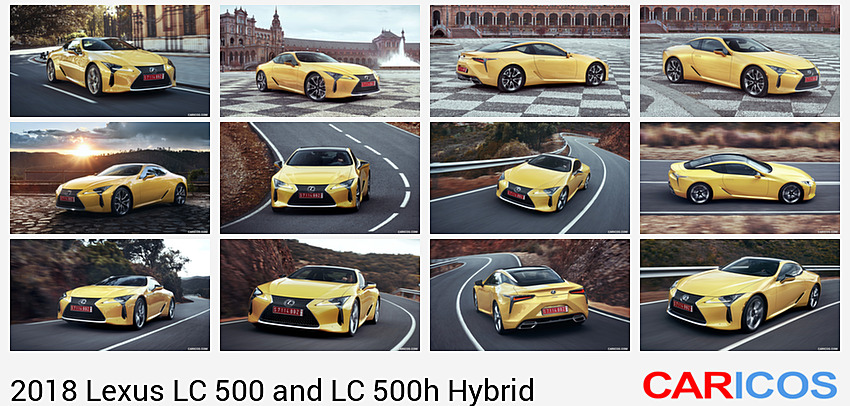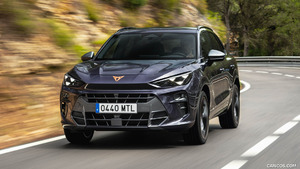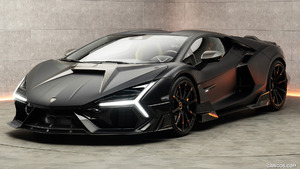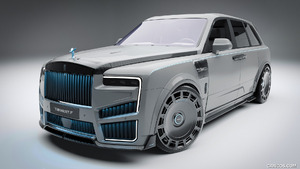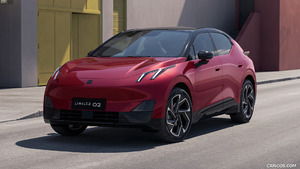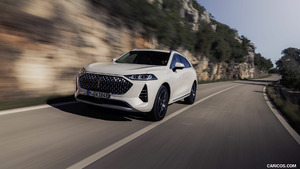Lexus LC 500 and LC 500h Hybrid
The introduction of the new LC performance coupe is a significant illustration of Lexus’ dedication to create cars with exciting, emotional designs and exhilarating performance.
In the space of just 27 years, Lexus has had a transformative effect on the world’s luxury car market. Engineering excellence has produced generations of powerful, responsive engines and transmissions, while its pioneering hybrid technology has taken efficiency and smoothness to ever higher levels. Cutting-edge design and a contemporary approach to luxury based on master craftsmanship traditions further emphasize its status as a world-class luxury vehicle manufacturer.
Now Lexus is building on its established strengths and evolving its reputation for vehicle development to explore new opportunities in design and technology that reshape its model range.
The change is being led from the top by Akio Toyoda, who in taking on the roles of Lexus’ Chief Branding Officer and master driver, has given the business more freedom, autonomy, and the confidence to be daring. With the benefit of dedicated resources, greater flexibility and quicker decision-making, Lexus has delivered a succession of vibrant new models that are changing the way it is perceived by both customers and the global automotive industry.
The striking NX crossover, the latest-generation RX, and the RC F and GS F performance models all demonstrate the great leap Lexus has made in crafting distinctive contemporary designs and delivering rewarding dynamic experiences—while retaining the luxury, quality, and attention to detail for which it has always been renowned.
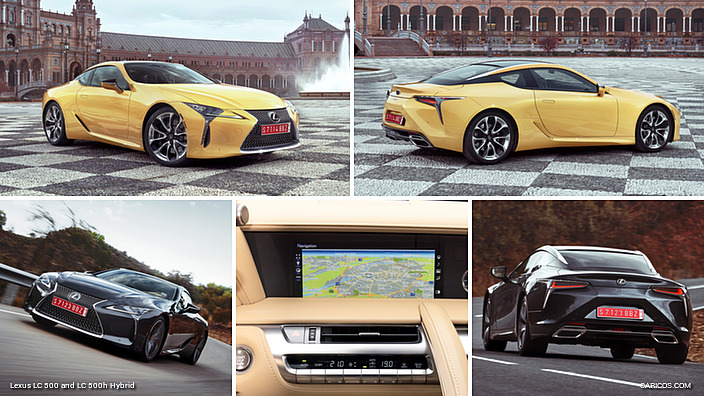 2018 Lexus LC 500 and LC 500h Hybrid
2018 Lexus LC 500 and LC 500h Hybrid
The LC coupe takes this evolution to another level. Lexus has succeeded in turning its LF-LC concept into an uncompromised production car, in less than five years since its unveiling to huge critical and public acclaim. This feat has called for new ways of cooperation between the design and engineering teams throughout the development process.
Not only has Lexus delivered a design with high visual impact, it has also developed ground-breaking engineering and technology for the LC. The LC 500h features Lexus’ new Multi Stage Hybrid System, which offers enhanced performance across engine speeds, a more direct response to driver inputs, and a higher level of dynamic performance and driving pleasure – all while maintaining the smoothness and efficiency that are characteristic of Lexus hybrids. The LC 500, powered by a normally aspirated 5.0-liter V8 engine, also marks a first in the premium car segment with its new Direct Shift 10-speed automatic transmission, featuring gear ratios spaced to achieve smooth, linear and rhythmical acceleration.
A FLAGSHIP COUPE
The LC is a new flagship 2+2 performance coupe for Lexus’ global model range, not only showcasing the qualities of design, beauty, engineering and advanced technology that define it as a premium vehicle manufacturer, but also symbolizing its ambition as a luxury lifestyle brand. The Lexus LC will go on sale in the U.S. in Spring 2017.
The LC isn’t simply a car that looks good. It has been engineered in every dimension to deliver a very special driving experience. “Even sharper and more refined” were the constant watchwords as Lexus honed every aspect of the car’s performance, ride and handling. It is a contemporary interpretation of the finest traditions of the grand tourer, a coupe focused on the road, not the track. Its handling, responsiveness and comfort have been tuned to deliver a rewarding and hugely enjoyable experience.
The LC 500h marks a new step in the development of hybrid technology; it is the first model to benefit from Lexus’ Multi Stage Hybrid system. Adding a multi stage shift device to the 3.5-liter V6 hybrid powertrain helps transform the driving experience, witnessed in greater torque, more usable power across a wider range of engine speeds and rhythmic, linear acceleration that gives the driver the sensation of working with a 10-speed automatic gearbox. Moreover, these qualities are delivered with all the smoothness and efficiency for which Lexus Hybrid Drive is renowned.
The LC 500 is powered by the latest development of Lexus’ normally aspirated V8 gasoline engine, tuned to deliver 471 hp, with improved acceleration feel to the driver and the kind of engine note that only eight cylinders can deliver. This unit is matched to the aforementioned 10-speed direct shift automatic to offer a genuinely rewarding driving experience.
DESIGN
- Distinctive LC design based on award-winning LF-LC Concept car
- Avant-garde styling achieved through unprecedented level of cooperation between Lexus’ design and engineering teams
- Fluid interpretation of Lexus’ “seduction and technology” design theme
- Luxury 2+2 coupe proportions, with authentic front engine/rear drive design characterized by low hood and roof lines and aerodynamically efficient surfacing
DYNAMIC COUPE DESIGN
The LC’s exterior design is immediately recognizable as being a masterful reinterpretation of the styling of the LF-LC concept, winner of an EyesOn Design award when first revealed at the 2012 North American International Auto Show (NAIAS) in Detroit.
Making the show car’s styling a practical proposition for a full production car required a new way of working at Lexus, bringing the engineering and design teams together with an unprecedented degree of cooperation to achieve the desired results, with hard work fueled by a shared desire to make the LC a success, without compromise. At the same time as the challenge of the exterior design was taken, a new cabin was created, combining a driver-focused cockpit with an open and welcoming space for passengers.
The success of this team was proven when the LC won two additional EyesOn Design awards when it was revealed at the 2016 North American International Auto Show (NAIAS).
An unprecedented design challenge
The unveiling of the LC coupe at the 2016 NAIAS revealed that Lexus had carried forward the promise of the LF-LC concept, producing a dynamic coupe with an exterior design that is radical yet elegant, with commanding visual impact.
The delivery of such uncompromised styling was at the heart of the project led by Chief Engineer, Koji Sato, and Chief Designer, Tadao Mori. Their work was inspired by the hugely positive media and public reception for the LF-LC and the personal support of Akio Toyoda, who saw the concept as a route to introducing more emotion into the Lexus brand.
Translating the styling of the 2012 LF-LC concept into a viable production model was a complex challenge, considered by Sato as the greatest Lexus had undertaken since the development of the original LS. Its successful achievement called for new ways of collaboration between the engineering and design teams right from the start.
Sato explains: “While maximizing the fundamental taste of the LF-LC, we applied completely different specifications to create a design that goes beyond the concept—a design that will captivate you as soon as you see it. In my view, pursuing beautiful design and elaborating great performance is very similar. Beauty is the identity of Lexus’ design. Every feature on the LC is the result of an integrated approach to design and engineering. All the teams worked together—engineers and designers alike. This is why we have been able to create such a great car.”
New Global Architecture – Luxury platform
The desire was to preserve the LF-LC’s defining low roof and hood lines, while ensuring the packaging allowed the LC to match the concept in accommodating a sport suspension and 21-inch forged alloy wheels. At the same time, all powertrain, chassis and safety components had to be housed and comfortable headroom had to be provided in the cabin. The teams had the benefit of working on a completely new GA-L (Global Architecture – Luxury) platform, designed for new generations of front engine/rear-wheel drive Lexus models.
As an example of the teams’ commitment to success, the front suspension components went through six months of re-working the multilink suspension control arm geometry until the required low hood line was achieved, without compromising suspension performance. Other clever solutions were developed, such as the new ultra-slim LED headlight unit design, which allowed the LC to retain exceptionally short front overhangs.
EXTERIOR: AVANT GARDE ELEGANCE
The LC displays performance coupe proportions with an exterior design that projects an avant-garde elegance, remaining faithful to many of the defining features of the LF-LC concept car that inspired it. The design wraps the car in a glamorous body that represents an evocative and fluid interpretation of Lexus’ “seduction and technology” design theme.
Athletic profile
The coupe’s athletic profile is characterized by its sweeping roofline, which tapers rearward from above the centrally positioned cabin to create a distinctive silhouette. Chrome-plated moldings along the side of the glass roof amplify the elegant coupe profile, their rear edges shaped to echo the lines of a traditional Japanese sword. The blacked-out finish to the roof and rear pillars creates a floating effect that visually separates the roof from the rear spoiler.
The LC’s appearance can be made even more dynamic with the addition of an optional Carbon Fiber Reinforced Plastic composite roof and active rear spoiler.
The LC has a 2,870mm (112.99 in.) wheelbase and—in a direct reference to the styling of the LF-LC— very compact overhangs (920mm/36.22 in. front, 970mm/38.19 in. rear) and a notably low hood line.
The prominent front and rear spoilers flare away from the center of the car, housing wide, large-diameter wheels, while the door panels are pulled inwards, creating a powerful three-dimensional form that mirrors the spindle shape of the Lexus grille.
The LC can be outfitted with 20-inch cast aluminum or available 20 and 21-inch forged aluminum alloy wheels.
Front design
The spindle grille itself – a hallmark of Lexus design – is finished in chrome and has an arresting new mesh design with visual tension that changes as it spreads across the front of the car. The unique LC lighting signature is created by independent daytime running lights in an arrowhead configuration and ultra-compact triple LED headlamp units. Achieving this remarkably slim headlight design played an important role in helping the designers achieve the coupe’s low hood and short front overhang.
Rear styling
At the rear the roof tapers down between muscular wheel arches, reinforcing the car’s wide and stable stance. The Lexus spindle shape is visible here in a three-dimensional form that is generated by lines flowing from the front of the car and along the sides, before cutting back around the inner edge of the rear combination lamps. The line of the spindle then moves outwards, following the shape of the license plate mounting and outer edges of the tailpipes.
The rear combination lamps, set vertically at the outermost edge of the bumper, have a graphic that guides the eye in three directions, accentuating the flow along sides of the body and emphasizing the vehicle’s strong, planted look. The use of several different materials in the lens and bezel provide a further indication of the sophisticated workmanship invested in the LC. Within the combination units, the taillights feature a new Lexus concept, using mirrors to create a multi-reflection, three-dimensional sequence of L-shaped graphics.
AERODYNAMICS
As much as Lexus sought to carry forward the sensuous styling of the LF-LC concept into the production LC, it also worked to introduce a high level of aerodynamic performance to enhance the coupe’s handling and ride quality while suppressing wind noise.
The aim was to achieve a smooth, unbroken front-to-rear airflow both over and beneath the body. Design elements that help control and direct the airflow include small but critical aero stabilizing fins on the front pillars, just forward of the door mirrors. Just a 5mm difference in their size or position can affect the car’s handling and level of wind noise.
An available active rear spoiler is automatically deployed when vehicle speed rises above 80km/h (50 mph). This suppresses lift at the rear to help provide a high degree of stability when driving at speed.
Aero ducts are featured just forward of the rear wheel arches, serving a highly practical function as well as contributing to the dynamic power of the LC’s styling. These feed air into the wheel arch, which then exits smoothly across the sidewall of the tire. This contributes to the car’s high-speed straight-line stability and steering responsiveness and generates an enhanced grip feel from the rear tires, for example when changing lanes.
The treatment of the underbody has been given equally close attention, with an almost completely smooth finish. Parts are aligned with the aero line, which kicks up towards the rear – notably the silencer is angled upwards, like a diffuser.
DYNAMIC LUXURY INTERIOR
The dynamic luxury theme of the exterior is carried through into the LC’s 2+2 cabin. This space is designed to provide sophistication and intricate attention to detail with a driver-focused cockpit.
Cabin design
The area around the front passenger spreads outwards to create a comfortable and welcoming space. In fact, the flowing line of the door trim is an extension of an exterior line that flows from the hood and through the windscreen, building a sense of continuity between the outside and inside of the car.
The driver’s cockpit has been ergonomically designed to instill confidence and invite spirited driving, with an intuitive layout of the controls and an excellent seating position. The driver’s hip point has been located as close as possible to the coupe’s center of gravity, maximizing direct feedback of the vehicle’s dynamic performance. The driver also enjoys an excellent view of the road, uncompromised by the low seating position thanks to the low hood line, the low-profile instrument panel and the location and narrow width of the front pillars. The shallow height of the instrument panel has been helped by the development of compact air vents.
Ease of access
Lexus has ensured getting in and out of the LC is easy and comfortable by providing generous legroom beneath the instrument panel, reducing the height difference between the rocker panel and the vehicle floor, and enlarging the door aperture to provide comfortable head space.
Steering wheel and controls
Particular attention has been paid to the steering wheel design, with a change in the cross-section around its circumference to allow for variations in grip and twisting of the wrist. New, larger magnesium alloy paddle shifters allow for easier hooking with the fingertips and a substantial feel when used.
The instrument panel has a taut and rigid frame that creates a strong horizontal axis. All the principal instrumentation and function controls are contained within its cross-section.
The information displays are arranged in order of importance, with the most critical positioned closest to the driver’s sightline, within the dashboard’s upper display zone. All are positioned at the same height, to reduce the degree of eye movement required for the driver to read them. The instrument binnacle houses the latest development of the thin film transistor (TFT) meter technology introduced in the Lexus LFA supercar, including a moving central ring.
Driving-related switches and controls are arrayed in a control zone that is concentrated immediately around the steering wheel. These include the paddle shifters, steering wheel combination switches, Drive Mode Select switch, starter button and shift lever. The center console features the latest-generation Remote Touch Interface touchpad control, with quick and intuitive operation.
Throughout the cabin the quality and finish of the upholstery, trim materials and detailing reflect the Takumi craftsmanship and fine attention to detail for which Lexus is renowned worldwide. It can be witnessed in the hand-stitching of the leather-wrapped gearshift lever, the draping treatment of the Alcantara door panel trims, and the discreet use of the Lexus “L” motif in areas such as the face of the analog clock and the tactile raised surfaces of the air vent controls.
Seat design
Providing the driver with a seat with the best possible combination of support and comfort was a focus point in the development of the LC’s cabin. Chief Engineer Sato himself was involved in the process for developing a new design that went through an exhaustive 50 test cycles.
The aim was to deliver an advanced design with excellent holding performance and superb comfort. Lexus has achieved this with a new two-part construction technique in which the main part of the seatback drapes over the shoulder area of the seat and wraps around the back. To ensure superior lateral support, additional bolstering is provided for the driver’s shoulder blade area, and resin inserts enhance the holding performance of the side bolsters. On the available sports seats, the bolsters are even more substantial, with a focus on keeping the driver’s back in place in high-speed cornering.
The seat cushion has been shaped to ensure excellent support for the pelvis, so that pressure is evenly distributed to the front and back.
Interior colors
Available interior color schemes for the LC include new Bespoke White and Mid Brown shades, together with Lexus’ established Rioja Red and Black finishes. The color options and combinations allow customers to create a distinctive and individual cabin that projects a sporty or luxurious look.
The Bespoke White color is exclusive to the LC, combining a mid-blue finish for the upper door trims, steering wheel, instrument panel and center armrest with contrasting white seat upholstery and vivid orange for the door panels and shift lever surround. The Mid Brown option provides a monotone finish throughout the interior in warm harmonizing shades of brown, producing a highly luxurious effect.
EXHILARATING PERFORMANCE
- LC is the first model to be constructed on the new Lexus ‘Global Architecture – Luxury’ front engine/rear-wheel drive platform
- GA-L platform allows for a low center of gravity and the setting of a new driving position
- Superb body rigidity with highest torsional stiffness of any Lexus model yet
- Strategic use of different steels, aluminum and Carbon Fiber Reinforced Plastic to achieve the optimal combination of strength, light weight and weight distribution
- Detailed management of inertia specifications, using low center of gravity, vehicle mass distribution and moment of inertia to achieve sharp and refined dynamic performance
- New multi-link front and rear suspension and adoption of run-flat tires
- Lexus Dynamic Handling with Limited Slip Differential ensures sporty handling and steering response
The LC is the first car to be developed on Lexus’ new front engine/rear-wheel drive Global Architecture – Luxury (GA-L) platform, which gives Lexus the ability to take design and performance to another level— fundamental to its future direction as more emotionally driven brand.
NEW GLOBAL ARCHITECTURE – LUXURY PLATFORM
The design and quality of the GA-L platform have given Lexus the opportunity to craft a highly rigid body with excellent noise and vibration characteristics. It plays a pivotal role in the new LC’s dynamic performance, enabling a low center of gravity to be achieved and a completely new driving position to be defined. Low vehicle mass, ideal weight distribution and the accommodation of finely tuned new multilink suspension systems add to the dynamic benefits of the platform’s design.
High body rigidity
The goal of obtaining emotional driving dynamics has been achieved by ensuring exceptional body rigidity and careful management of the inertia specifications (detailed in the section below).
Materials with different properties have been used in different areas of the coupe’s construction, giving strength, rigidity and light weight in appropriate measure – in essence, “the right material for the right job.” The application of different materials can be broken down into six separate functions. To create a strong frame that helps provide robust cabin integrity, certain parts are made of ultra-high-tensile strength steel, while high tensile steel with good elastic properties is adopted for elements that are designed to deform in an impact to help dissipate energy. The rigidity of the frame is supported by general steel with a high degree of stiffness, and aluminum is used strategically for its excellent energy-absorbing performance and for external bodywork where its lightness and tensile rigidity are of value. Finally, strong yet lightweight Carbon Fiber Reinforced Plastic (CFRP) is featured inside and out.
Inertia specifications
Precise control of the LC’s inertia specifications played an important part in achieving the “even sharper, more refined” quality Lexus sought for its flagship coupe. This included giving the car a low center of gravity and balanced front-to-rear weight distribution.
The quality of the new GA-L-based platform gave the opportunity to rethink packaging to improve the inertia specifications and achieve an excellent combination of what are seemingly contradictory qualities – handling control and ride comfort. The principal elements included locating the tires outwards to the corners of the vehicle, reducing overall weight, lowering the driver’s hip point and moving the engine 50mm (1.96 in) rearward. The elimination of a spare tire in favor of run-flat tires and relocating the battery to the luggage space further helped balance the car’s weight distribution.
By achieving a low center of gravity, Lexus was able to reduce the car’s roll angle without stiffening the springs and detracting from ride comfort. Overall the LC displays controlled body motion and precise, linear response, creating a rhythmical and smooth driving experience, notably when cornering and making lane changes.
The innovative packaging aimed at improving the inertia specifications also helped the designers in their mission to give the LC the dynamic visual appeal witnessed in the LF-LC concept. Moving the engine mass rearwards, behind the front axle line, results in a front/mid-ship configuration. This was essential for achieving the desired low hood line and making space for 21-inch wheels, giving the coupe a low, dynamic silhouette.
NEW MULTI-LINK SUSPENSION DESIGN
The layout of new front and rear suspension systems for the LC focuses on achieving excellent vehicle response and greater steering feel, from the moment the steering wheel is turned, supporting the “even sharper” quality Lexus sought for the coupe. At the same time, a higher degree of ride comfort was a priority, combined with stability to help give the driver peace of mind.
The new high mount front suspension system has an optimal arm design to secure the required level of steering feedback. Conversely, the rear suspension has a low mount configuration, with precisely defined arm locations to achieve high-stability steering characteristics.
Double ball joints are featured on each of the two upper and two lower control arms, allowing for control of the smallest movements from driver inputs and the road surface. This arrangement helps optimize the suspension geometry and create more precise steering response with better initial effort. Contributing to the LC’s weight-savings, the upper control arms are made of lightweight forged aluminium.
The driver can appreciate the effectiveness of the LC’s suspension designs in the car’s immediate response at initial turn-in, with the tires quickly developing lateral force, helping to deliver stability, controllability and ride comfort.
Run-flat tires
The specification of run-flat tires contributes to the LC’s efficient packaging, weight-saving qualities, optimum weight distribution and dynamic performance.
By avoiding the need to accommodate a spare wheel, Lexus has been able to save weight and free up space to locate the sub (or auxiliary) battery in the luggage compartment, helping achieve the required front/rear weight distribution. At the same time, a larger loadspace could be designed, without compromising the coupe’s swooping profile.
The quality and performance of run-flat tires have improved significantly as manufacturers make important advances in the application of new design, tread patterns and material compounds, giving both high performance capabilities and everyday ride quality, durability and safety. Improved resistance has also been achieved, allowing the tires to make a contribution to the vehicle’s overall fuel efficiency.
The tires’ increased lateral stiffness complements the LC’s highly rigid suspension, while vertical stiffness has been reduced to favor ride comfort.
Tire sizes are 245/45RF20 front and 275/40RF20 rear with 20-inch wheels, and 245/40RF21 front and 275/35RF21 rear with 21-inch wheels.
LEXUS DYNAMIC HANDLING WITH LIMITED-SLIP DIFFERENTIAL
The available Lexus Dynamic Handling system’s role is to provide the LC with a heightened sense of handling in a wide variety of driving scenarios, achieved through the coordination of the car’s Variable Gear Ratio Steering (VGRS), Active Rear Steering (ARS) and Electric Power Steering (EPS) functions.
The result is enhanced steering response, true to the driver’s inputs, and a more direct response in high-speed cornering, giving a greater feeling of security. By equipping the LC with a limited-slip differential, Lexus helps the driver to enjoy secure acceleration while cornering; cooperation between the new Vehicle Stability Control (VSC), ARS and the LSD is designed to counteract over- or understeer to help the car keep to its intended line.
The quality of the steering system has been carefully engineered to suppress unwanted vibration while adding extra rigidity to the steering column to communicate a sense of security and responsiveness. The sharp, linear response of the EPS gives a natural feel, while taking handling precision to a higher level for a more rewarding driving experience.
ENGINE SOUND
Lexus considers the sound of the engine to be an important contributor to delivering a multi-sensory driving experience, and the new LC has gone to great lengths to achieve a truly emotional engine sound. In fact, engineers worked to combine the sounds produced by the air intake system at the front and the exhaust system at the rear to create what they describe as a “concert hall” effect inside the cabin, both as the car gains speed and slows down.
The sound has been developed specifically for the LC, to reflect the coupe’s specific performance qualities. As speed increases, the sound has an excellent tonal quality and harmony and a depth that expresses a pulsating feel.
On the LC 500’s V8 engine, the front air intake is fitted with a sound generator, with carefully engineered dimensions tuned to maximize the desired sound frequency and level. The opening is directly connected to the cowl reinforcement, so sound reverberates within the enclosed space, resulting in a natural, emotional quality.
At the rear, additional external valves have been introduced in front of the main muffler, which open and close according to the driver’s use of the throttle and the drive mode selected. The length and diameter of the main muffler pipe has also been adjusted.
POWERTRAINS
- LC 500h powered by 3.5-liter V6 full hybrid powertrain
- First model to benefit from Lexus’ new Multi Stage Hybrid System, delivering greatly enhanced torque and acceleration performance
- Compact and lightweight lithium-ion hybrid battery
- LC 500 features latest development of Lexus’ 5.0-liter V8 engine, matched with the first direct shift 10-speed automatic transmission to be featured in a luxury car
TWO POWERTRAINS: 3.5-LITER V6 FULL HYBRID WITH MULTI STAGE HYBRID SYSTEM AND NORMALLY ASPIRATED 5.0-LITER V8
The Lexus LC gives customers the option of two powertrains, both of which benefit from numerous advanced technologies to achieve a dynamic performance that fully complements the finely tuned handling qualities of the coupe’s chassis.
The LC 500h marks the start of a new era in full hybrid technology, the introduction of Lexus’ new Multi Stage Hybrid System. This transforms torque, power and acceleration through the addition of a new multi stage shift device to the powertrain, while still preserving the smoothness and efficiency for which Lexus hybrids are renowned.
The LC 500 is powered by Lexus’ 5.0-liter normally aspirated V8 gasoline engine, matched to a new close-ratio Direct Shift 10-speed automatic transmission – a first for a premium passenger car. Generating maximum power of 471 hp thanks to an optimized intake and exhaust layout and engine control, it provides rapid, rhythmic acceleration accompanied by an engine sound that expresses the V8’s power.
LC 500h WITH 3.5-LITER V6 FULL HYBRID POWERTRAIN
The 3.5-liter V6 gasoline engine featured in the LC 500h’s full hybrid powertrain delivers efficient environmental performance without sacrificing powerful driving performance reaching up to 6,600rpm.
A series of detailed design and engineering measures have been taken to fine tune performance, including a reduction in the diameter of the cylinder intake port to increase flow speed and efficiency, contributing to excellent power output and a feeling of continuous acceleration. The engine makes good use of Dual VVT-i (intelligent variable valve-timing), with timing precisely gauged in line with driving conditions, helping secure high torque at all engine speeds.
Measures to reduce friction losses and thus help enhance engine efficiency include the adoption of narrow, lightweight roller rocker arms and low-friction timing chains, while D-4S direct fuel injection helps create optimum combustion conditions, contributing to enhanced fuel efficiency.
IMAGINATIVE TECHNOLOGY: NEW MULTI STAGE HYBRID SYSTEM
The LC 500h introduces Lexus’ first Multi Stage Hybrid System, a technology that delivers a revolution in hybrid powertrain performance and promises to the perception of the kind of driving experience a hybrid can provide.
Chief Engineer Koji Sato explained: “In the past, people only associated hybrid with ‘eco’. We wanted to broaden that perception and create a true high-performance powertrain.”
The Multi Stage Hybrid System amplifies engine and motor output thanks to a new multi stage shift device, which changes the output in four stages in order to utilize the engine speeds across the whole speed range. This creates a system that responds much more directly to driver inputs and achieves a higher level of dynamic performance and driving pleasure, while maintaining the smoothness and efficiency that are characteristic of Lexus vehicles.
Improved torque and acceleration
The success of the Multi Stage Hybrid System is central to the “even sharper” quality Lexus targeted for the LC, providing responsive, direct and rhythmical acceleration with good grip. In fact, such is the level of torque and acceleration when pulling away from a complete stop, the LC 500h tests the limits of tire grip and, according to Sato, is the first Lexus hybrid that can spin its rear wheels.
In a conventional full hybrid vehicle, engine output is amplified by the electric motor via a reduction gear, but with the new Multi Stage Hybrid System the power from the V6 engine and the electric motor can be amplified by the automatic transmission, allowing much greater drive power to be generated when accelerating off the line.
Lexus has succeeded in increasing maximum engine rpm from 6,000 to 6,600 rpm. And thanks to the Multi Stage Hybrid System, the operating range in first, second and third gears has been increased, so that maximum rpm is reached at about 50km/h (31 mph).
Transmission with 10-speed feel
Although the multi stage shift device changes the output in four stages, the D range has a simulated shift control pattern that replicates the feel of driving with 10 gears. As vehicle speed rises, engine speed increases with a linear, direct and continuous acceleration feel that avoids the “rubber band” effect witnessed in some continuously variable transmissions. In the 10th gear range, the CVT control allows for cruising at lower engine revs for quiet, smooth and more fuel-efficient performance.
In a first for a Lexus hybrid, the transmission benefits from an enhanced version of the AI shift control found in conventional automatics. This enables intelligent, optimum gear selection to be made in line with driving conditions and driver inputs, for example when going up or downhill. The system also includes an automatic Drive Mode switching control. This means it can adjust gear shifts to suit the driver’s style and behavior, without the driver having to select a different drive mode to get the kind of performance they want from the transmission.
M mode with manual gear selection
With the Multi Stage Hybrid System’s design, the driver is able to take advantage of a manual mode to select and hold gears using paddle shifters mounted behind the steering wheel – a function not previously available on a Lexus hybrid. Due to the coordinated control of the Power Split Device and the gear shifting mechanism, the shift will start instantaneously with the computer receiving the signal from the paddle.
LITHIUM-ION HYBRID BATTERY
The LC 500h is the first production Lexus to use a compact, lightweight, lithium-ion hybrid battery. Twenty percent smaller than the nickel-metal hydride unit featured in the Lexus LS, it fits neatly between the rear seats and the luggage compartment and has a higher power density, with its 84 cells producing 310.8 Volts.
Using lithium-ion technology has also reduced the component’s weight, helping reduce the LC 500h’s overall mass, and contributed to the effective management of the car’s inertia specifications. This supports overall fuel economy, emissions performance and the coupe’s handling balance.
It is also the first Lexus hybrid battery to feature a satellite construction design, in which the cell voltage monitoring function has been made separate from the battery ECU. This allows for efficient use of what would otherwise be empty space inside the battery pack to house the wiring harness and battery cooling blower, thus reducing the unit’s overall dimensions. The cooling blower itself has been made more powerful and thinner in size.
Adopting lithium-ion battery technology results in more compact packaging, helping to ensure that luggage space is maintained. It also assists in reducing the overall vehicle weight.
LC 500 WITH 5.0-LITER V8 ENGINE
The performance heart of the LC 500 is Lexus’ high-revving (maximum 7,300 rpm), normally aspirated 5.0-liter V8 gasoline engine. It is a development of the Atkinson cycle unit which has been deployed to good effect in the GS F and RC F, its performance supported by advanced D-4S fuel injection technology.
The V8 supports the essential dynamic character of the performance coupe, providing smooth, linear throttle response and generating a stirring engine note. Maximum power of 471 hp delivered at 7,100 rpm, with maximum torque of 398 lb.-ft. generated at 4,800 rpm. This gives the LC 500 a zero to 60 mph sprint time of less than 4.5 seconds. The intent is to give the driver the responsiveness and high output customers expect from a normally aspirated unit.
The engine is designed for durability and has a lightweight construction, with high-strength, forged connecting rods and titanium valves that allow it to flourish at high revs. A dual intake inlet enables efficient breathing and contributes to the unit’s distinctive sound. Noise and vibration have been reduced by the use of a double torsional damper on the crank pulley, while fuel efficiency is supported by the use of D-4S direct fuel injection, Atkinson cycle operation, optimized VVT-i operation and a high compression ratio. Extensive measures have also been taken to reduce friction and pumping losses.
IMAGINATIVE TECHNOLOGY: NEW DIRECT SHIFT 10-SPEED AUTOMATIC TRANSMISSION
In designing a new Direct Shift automatic transmission for the LC 500, Lexus sought to avoid the drawbacks of systems where driving pleasure is diminished by the wider spacing of the higher gears, often producing an unappealing, drawn-out engine sound. It recognizes the critical role the transmission plays in generating a rhythmic drive through good feedback and quick shifts that respond instantly to the driver’s wishes.
The solution is a new 10-speed unit with close ratios that bring the gears closer together, and even spacing between each gear.
An extra gear was added to eliminate the feel of second and third gears being drawn out for too long, and a 10th gear has been provided to allow for efficient high-speed cruising at reduced engine rpm. The system provides some of the world’s quickest shifts, giving a crisp feel, fast response, rhythmic shifting with no “shock” effect, and a harmonized engine sound, contributing greatly to the aim of making the LC “sharper and more refined”.
In a first for Lexus, the transmission uses an AI-SHIFT control with a drive mode switching function. This selects the optimum gear according to its estimation of the driver’s preferences and intentions, based not just on vehicle speed and use of the accelerator, but also from past driving history. The system will adapt gear selection to suit, even if the driver has not used the Drive Mode Select switch.
The transmission benefits from a new torque converter with full range lock-up control to support the delivery of a direct feel and eliminating unnecessary revving of the engine. Thanks to intelligent design, packaging, and exhaustive weight-saving measures, the complete unit is comparable in size and weight to Lexus’ current eight-speed automatic. Low-friction materials have been used where possible to support fuel economy and the number of internal parts – planetary gears, clutches and brakes – has been kept to a minimum.
TAKUMI CRAFTSMANSHIP
- LC quality and performance benefit from the precision skills of Lexus’ Takumi master craftspeople
- Motomachi factory provides ideal environment for dynamic luxury coupe manufacturing
- High-quality interior materials benefit from hand-finishing and stitching
- Continuous, detailed refinement of driving dynamics
The skills of Lexus’ master craftspeople – the famous Takumi – are central to the exceptional quality Lexus delivers in every car it builds. The new LC benefits from this precision approach, not just in the intricate details of its fittings and finishes, but also in the way the car rides and performs. Throughout, the experience and finely tuned judgement of the Takumi have been brought to bear in securing the best possible results.
THE MOTOMACHI FACTORY, HOME OF THE LEXUS LFA AND THE LC
The LC is built at Lexus’ Motomachi plant, famously home to production of the hand-crafted LFA supercar. The factory’s layout and its facilities have been tailored to the production of the LC, to ensure the highest quality levels.
Many of the Takumi and skilled workers who built the LFA transferred to the LC project, bringing with them a wealth of knowledge and experience, particularly in areas such as the handling of carbon fiber components and hand-finishing.
The new production line at Motomachi has a pure white finish from floor to ceiling to create an environment that helps the team members focus on their work. Each person will spend as much as 20 minutes working on every car, combining hand and eye skills with the use of tablet devices to check and re-check the quality of each process. Skills – both mental and technical – are constantly developed to support a “no compromise” mindset when it comes to achieving Lexus’ rigorous quality standards.
Final checks are carried out in a glass-walled inspection booth with LED lighting – even set into the floor – to ensure the precision finish of all surfaces and bodywork panels, the evenness of color, the quality of the interior and the operation of functioning parts. The substantial thickness of the glass walls also allows the smallest abnormalities in sound to be detected in dynamic checks that monitor noise and vibration.
INTERIOR FINISHING
Here the skills of the Takumi can be seen in precise stitching that maintains a flawless finish where leather spreads across complex surfaces. The draping effect of the Alcantara in the door panels and the arrangement of the perforations in the leather seat upholstery are further hallmarks of the attention to detail invested in creating a perfect cabin environment.
The shape and feel of the steering wheel – a critical link in communicating the quality of the LC’s performance to the driver – were defined through hours of testing and re-testing by a Takumi master driver. His exhaustive analysis produced a highly complex cross-section design. The profile for each section of the wheel produces the ideal shape to suit the driver’s changing grip and hand position as they steer. The same process was applied to developing the shape and action of the paddle shifters for manual gear selection. Crafted in cool-to-the-touch magnesium alloy, they have a finely defined profile for ease of use and they operate with a satisfying click-response.
HAND-CRAFTED GEAR SHIFT KNOB
The construction and finishing of the gear shift knob exemplifies the craftsmanship and attention to detail that is invested throughout the vehicle. Great efforts have been invested in ensuring this highly tactile part conveys the level of quality that can only be delivered by skilled craftspeople.
The knob is leather-wrapped, in keeping with the extensive use of fine leather in the LC’s cabin, created using an in-stitch method that keeps the stitching concealed. The seams are straight thanks entirely to the advanced skills of the Lexus craftspeople (the sewing margin is just 2mm (0.08 in), while the size and shape of the stitch holes, the thickness of the needle and the angle of the needles are all subject to constant checks to ensure perfect consistency.
The metal parts are slightly recessed, so the palm of the driver’s hand feels only the leather surface when using the shift lever. Different parts of the knob have contrasting tactile qualities: the top is smooth and soft, with a urethane sheet adding a degree of flexibility, while the perforated leather surface on the knob’s rear section is harder to the touch, adding a telling sensation to each shift change.
HIGH-SPEED RESIN TRANSFER MOLDING (RTM)
The finish of the LC’s Carbon Fiber Reinforced Plastic (CFRP) has a twill weave effect, made possible by a new, high-speed resin transfer molding (RTM) process, developed at the Motomachi factory from a technique originally used in production of the Lexus LFA. Raw carbon fiber material is inserted into a mold and clamped in place before the insertion of the resin material. As a result, the process has been made suitable for volume production. The use of the CFRP roof makes a major contribution to the coupe’s low center of gravity and reduces overall weight.
SELF-PIERCING RIVETS
Lexus has adopted a new technique for combining aluminum with steel to help save weight in key areas, notably the construction of the front suspension towers.
The use of self-piercing riveting allows these different metals to be securely joined where traditional welding methods are unsuitable: in place of spot-welding, the material is pierced on its upper side only.
DRIVING DYNAMICS
The skills and experience of the Takumi were further invested in securing excellent driving dynamics for the new performance coupe. The aim was to ensure that the promise of a great drive expressed by the car’s styling and the sound of the engine upon start up is delivered when a driver gets behind the wheel and drives away.
The sharpness and responsiveness of the steering, the strong, rhythmic progress of the transmission, the supportiveness and comfort of the seats and the position of the driver’s feet and the pedals – all these elements and more were scrutinized to produce the best possible combination, with the goal not just of a rewarding drive, but performance that actively makes one want to drive.
Prototypes were assessed on all kinds of roads, including in Europe and the USA, to help ensure that its ride and handling meet the different demands of drivers and driving conditions around the world. The Takumi master driver works exclusively on the LC to maintain a complete focus, making fine adjustments to achieve the best results, right up to the start of production.
AUDIO SYSTEMS
Mark Levinson
13-speaker Mark Levinson audio system uses innovative technologies to deliver concert hall quality sound
Lexus has enjoyed an auto industry-exclusive partnership with Mark Levinson since 2001, giving its customers the benefit of bespoke audio systems of the highest quality in its vehicles. The new LC follows in this tradition, offering Mark Levinson audio systems with exclusive equipment from their top-of-the-range Reference Product.
Designing the system to deliver the highest listening experience in the LC presented new challenges, as sound reacts differently in the compact cabin of the 2+2 coupe compared to a larger sedan or SUV. Mark Levinson specialists measured the sound frequencies produced in different parts of the cabin using 24 different microphones, producing data that helped them work with Lexus engineers to precisely locate the 13 speakers. “As a result, the audio system is able to make the cabin sound larger than it actually is, giving the listener the sensation of being in a concert hall rather than the interior of a vehicle,” said LC Chief Engineer Koji Sato.
The LC’s available Mark Levinson audio system also features Clari-Fi music restoration technology that enhances music playback by automatically analyzing and improving the quality of all types of compressed, digitized music sources. It identifies music signals that have been compressed and restores them in real time during playback to achieve an accurate and full listening experience.
Lexus Premium Audio
12-speaker premium audio surround system for real-life immersive soundscape
The LC can be equipped with a 12-speaker premium audio surround system. Specifically designed for the LC, this system integrates advanced technologies to accurately reproduce any sound source, resulting in a real-life, immersive soundscape.
The Pioneer system includes four innovative 9cm CST (Coherent Source Transducer) double speakers, combining tweeter and mid-range functions for optimal rendition of vocal frequencies, located at the basis of the A-pillars and in the back doors. The two 16cm woofers in the front doors are fitted in a special housing in order to reduce vibrations, resulting in excellent low-frequency sound generation. Other elements include a 9cm midrange speaker in the center of the instrument panel, a 25cm subwoofer in the back of the rear seats, and an 8-channel Class-D amplifier under the luggage compartment floor.
The speakers housed in the instrument panel are inclined to a certain angle ensuring that the sound directly coming from the speakers and the sound reflected by the windshield both reach the listener in the most efficient way to realize a rich, dynamic sound field.
LEXUS SAFETY SYSTEM+
- All LC models equipped with Lexus Safety System +
- Package of active safety features includes Pre-Collision System, All-Speed Dynamic Radar Cruise Control, Lane Departure Alert with Steering Assist, and Intelligent High Beam
- Lexus Safety System+ can help reduce the risk of an accident, alerts the driver to potential hazards and can help reduce the consequences should an impact be unavoidable
All versions of the LC are equipped as standard with Lexus Safety System+, a collection of active safety features that can help the driver avoid an accident, or help lessen the consequences of a collision.
The system uses a camera and a millimeter-wave radar to monitor the road ahead for potential hazards and collision risks. This provides the LC with a Pre-Collision System with Pedestrian Detection, which is designed to detect vehicles and pedestrians under certain conditions, All-Speed Dynamic Radar Cruise Control, Lane Departure Alert (LDA) with Steering Assist, a Sway Warning function, and Intelligent High Beam system (IHB).
PRE-COLLISION SYSTEM
Pre-Collision System with Pedestrian Detection
Utilizing both a camera and a millimeter wave radar system, the available Lexus Pre-Collision System with Pedestrian Detection uses sensors to detect other vehicles and/or obstructions in front of the vehicle. If the system determines that a collision is imminent, it will warn the driver via an audible warning as well as a visual alert through the Multi-Information Display.
Pre-Collision Brake Assist
If sensors detect an obstruction and the system determines that a collision is imminent, the available Pre-Collision Brake Assist system increases the brake force when the driver depresses the brake pedal.
If the system determines that a collision is potentially unavoidable and the driver does not apply the brakes or steering input, it will automatically activate the brakes, helping to reduce the impact force or avoid the collision altogether.
Auto Brake helps provide the driver additional assistance. The system will also issue an advance warning to the following vehicle by illuminating the vehicle’s brake lights before the driver begins to actually apply the brakes to notify the following vehicle that the LC will decelerate.
All-Speed Dynamic Radar Cruise Control
The same radar unit used by the PCS provides the LC with All-Speed Dynamic Radar Cruise Control. This helps the driver maintain a pre-set distance from the vehicle traveling in front, down to very low speeds and even to a stop. Once the way ahead is clear, the LC automatically and smoothly accelerates to its pre-set cruising speed. If the LC has been brought to a stop, the driver simply needs to press the accelerator briefly to reactivate the system.
Lane Departure Alert with Steering Assist and Vehicle Sway Warning
Lane Departure Alert (LDA) uses a camera on the windscreen to track the vehicle’s course between visible lane markings. If it judges that the vehicle is about to move out of its lane without the turn indicator being used, the system lights an indicator on the multi-information display and sounds a warning buzzer. It will also apply appropriate steering control force to help bring the vehicle back within the lane.
Steering Assist is designed to recognize when the vehicle is deviating from its clearly marked lane. It helps the driver steer the vehicle safely back to its correct path, automatically providing steering inputs to keep the car within its lane. Working with the cruise control, it can operate even at very low vehicle speeds. The driver can also choose which alert they prefer (warning sound or vibrating steering wheel) and the sensitivity of the warning, via the multi-information display. The system can also be switched off, if desired.
The system also includes a Vehicle Sway Warning function. The Sway Warning System incorporated into LDA with Steering Assist is designed to monitor the vehicle’s position within the lane and the driver’s steering inputs to detect unintentional vehicle lane departure. If the system detects unintentional lane departure, it will sound an audible alert and display a visual warning (steaming coffee cup) on the Multi-Information Display (MID). Vehicle Sway Warning activation, deactivation and sensitivity can be manually adjusted by the driver.
Intelligent High Beam
Lexus Safety System+ includes Intelligent High Beam (IHB), which is designed to detect oncoming traffic and vehicles ahead and automatically switches the headlights between high and low beam. This helps maximize illumination to give the driver the best possible field of vision when the road ahead is clear, while minimizing the risk of distracting oncoming cars.

